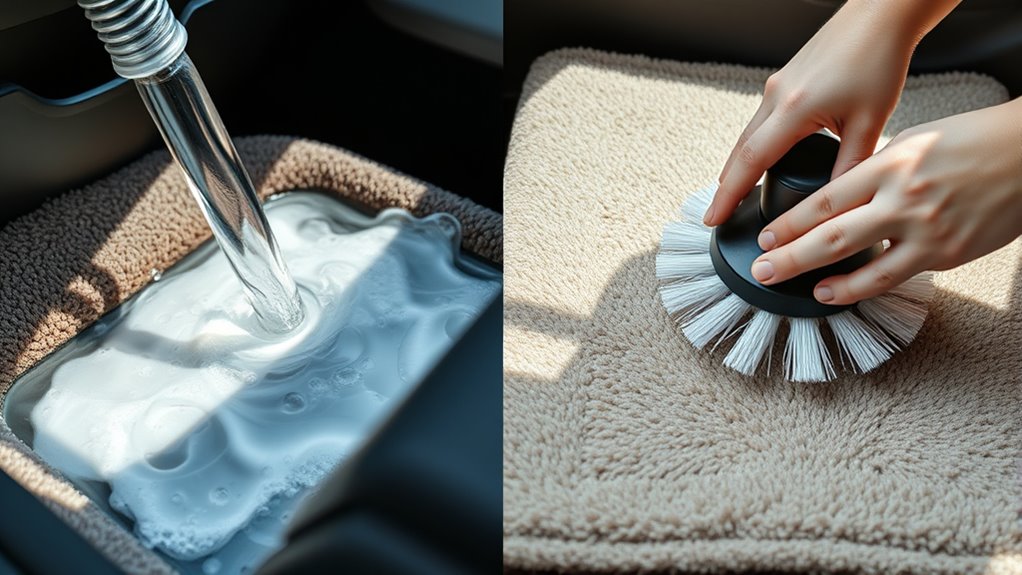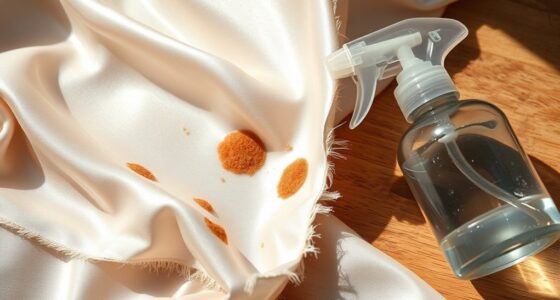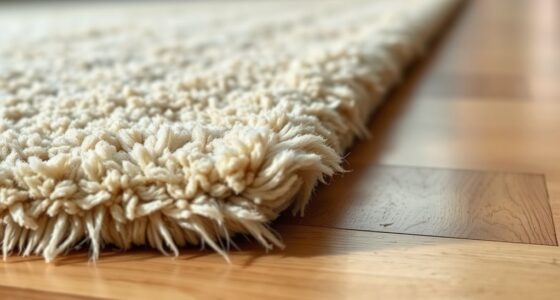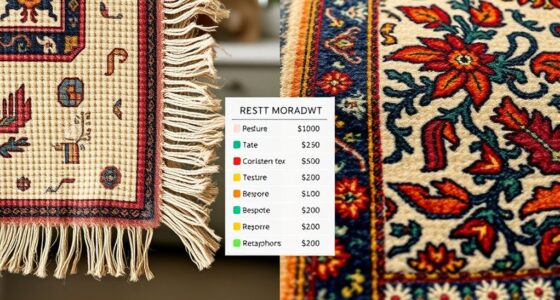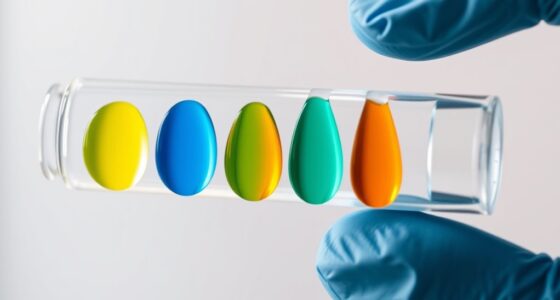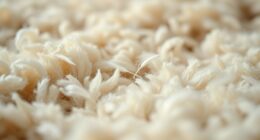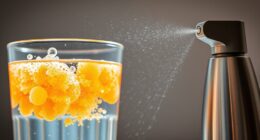Water extraction cleans deeply by removing embedded dirt and allergens, but it takes longer to dry and can cause damage if not done properly. Bonnet cleaning offers quick results with minimal moisture, ideal for surface stains and routine maintenance, but it may leave residues that lead to quicker re-soiling and doesn’t handle deep dirt well. To choose the best method for your needs, consider the pros and cons outlined here—more details await if you explore further.
Key Takeaways
- Water extraction effectively removes deep-seated dirt, allergens, and bacteria, unlike bonnet cleaning which mainly targets surface stains.
- Drying after water extraction takes 6–12+ hours, whereas bonnet cleaning dries quickly within about an hour.
- Water extraction is ideal for high-traffic and heavily soiled areas, while bonnet cleaning suits routine surface maintenance.
- Although water extraction has higher initial costs, it provides longer-lasting, thorough cleaning; bonnet cleaning is more budget-friendly but less deep.
- Proper residue management after water extraction prevents mold and damage, whereas bonnet cleaning may leave residues that cause rapid re-soiling.
Understanding Water Extraction and Its Benefits
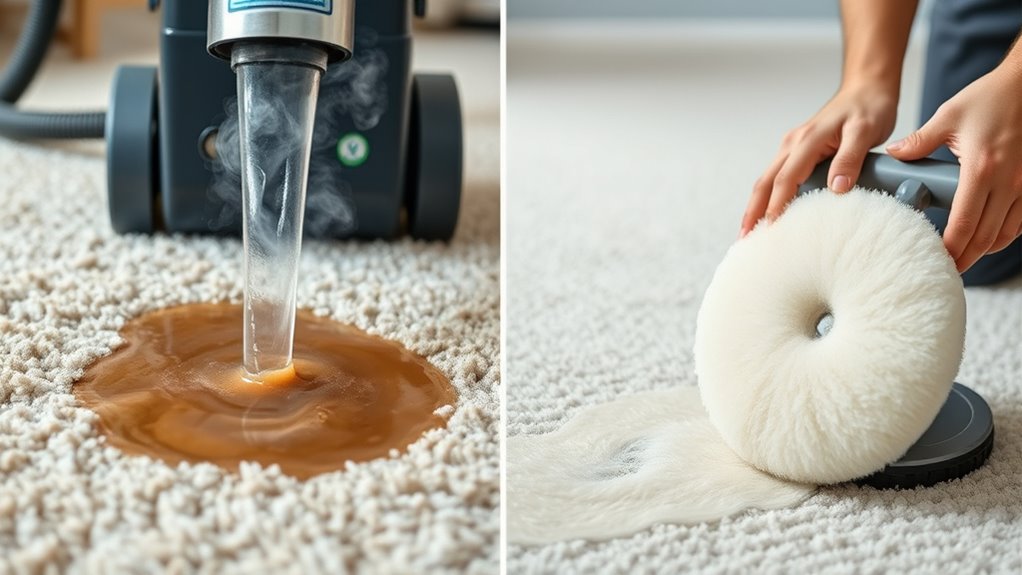
Water extraction is a highly effective method for deep cleaning carpets because it removes dirt, allergens, and bacteria from within the fibers. When you choose this technique, hot water and cleaning solutions are sprayed onto your carpet, loosening embedded debris. A powerful vacuum then extracts the water along with the dirt, leaving your carpet considerably cleaner. This method penetrates deep into the pile, reaching particles that surface cleaning methods might miss. It’s ideal for removing stubborn stains and improving indoor air quality by eliminating particles that can trigger allergies. Plus, because most of the moisture is extracted quickly, your carpet dries faster, reducing the risk of mold or mildew growth. Additionally, proper technique ensures that the carpet fibers are not damaged during cleaning, maintaining their longevity. Overall, water extraction provides a thorough, deep clean that refreshes your carpet and enhances your home’s hygiene.
Limitations of Water Extraction Techniques

Water extraction can leave behind residues that may attract dirt or cause odors over time. It also often requires extended drying periods, which can inconvenience you and prolong the cleaning process. Additionally, if not done carefully, this method risks damaging your carpet or underlying materials. Properly managing moisture levels is essential to prevent mold growth and additional health issues. Proper moisture control is critical for maintaining a clean and healthy environment after cleaning.
Residue Residual Risks
Have you ever considered that water extraction techniques might leave behind residues that pose risks? While effective at removing surface dirt, they can trap soil, cleaning agents, and moisture deep within the fibers. These residues can cause mold growth, unpleasant odors, or attract future dirt, compromising your carpet’s hygiene. To visualize this:
| Residues Trapped | Potential Risks | Long-term Effects |
|---|---|---|
| Soil | Mold growth | Carpet deterioration |
| Cleaning agents | Allergies | Discoloration |
| Moisture | Odors | Reduced lifespan |
This lingering debris can sometimes be invisible, but its impact is lasting. Proper extraction minimizes these risks, but incomplete removal can leave behind residues that threaten your carpet’s health and your indoor air quality. Additionally, understanding residue buildup is essential for selecting the most effective cleaning method and maintaining a healthy indoor environment.
Extended Drying Periods
While proper extraction can reduce residues, it often leaves carpets damp for extended periods. This can disrupt your schedule and increase the risk of mold growth. Consider these key points:
- Longer drying times can take 12–24 hours, depending on humidity and airflow.
- Extended moisture exposure may cause furniture and flooring to warp or swell.
- High humidity levels slow down evaporation, prolonging dampness.
- Immediate use of fans or dehumidifiers is necessary, adding to costs and effort.
- Ethical Hacking practices emphasize the importance of timely detection and remediation to prevent security breaches.
This delay can inconvenience you and impact indoor air quality. If you need quick results, water extraction might not be the best choice. Instead, look for cleaning methods that dry faster and minimize downtime.
Potential Damage Risks
Despite its effectiveness at removing dirt, water extraction can pose significant risks to your carpets and flooring. Excessive moisture can lead to mold growth, damaging the carpet fibers and underlying padding. If not dried properly, your carpet may develop a musty odor and become a breeding ground for bacteria. Overly aggressive extraction equipment can also cause fiber fraying or delamination, especially in delicate carpets. Additionally, water can seep into the padding or subfloor, leading to structural issues and costly repairs. Poorly maintained equipment or improper techniques increase the risk of water spots or discoloration. Proper GMC tuning techniques and equipment maintenance are essential to prevent these issues. You need to guarantee thorough drying and proper handling to minimize these risks, or you might face long-term damage that outweighs the benefits of deep cleaning.
Advantages of Bonnet Cleaning
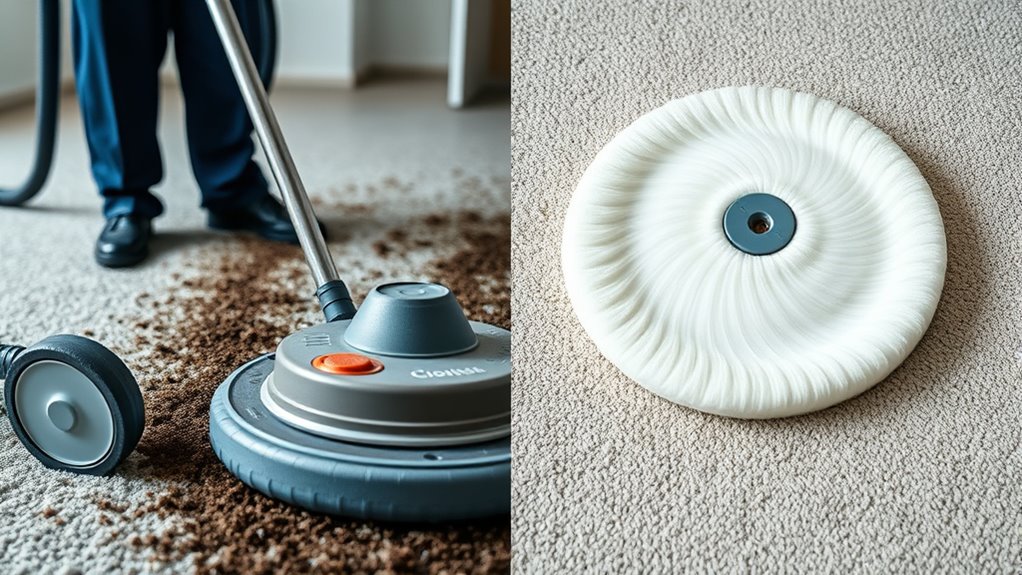
Bonnet cleaning offers several advantages that make it a popular choice for maintaining carpets. First, it provides quick results, allowing you to refresh your carpets with minimal downtime. Second, the process is cost-effective, making it suitable for regular upkeep without breaking the bank. Third, it’s ideal for high-traffic areas where frequent cleaning is needed to keep carpets looking fresh. Fourth, bonnet cleaning can effectively remove surface dirt and stains, improving overall appearance. This method is especially useful for routine cleanings between more intensive treatments. Its speed and convenience make it a practical option for busy environments. While it may not reach deep into fibers, bonnet cleaning keeps your carpets looking clean and presentable, making it a valuable part of your maintenance routine. Additionally, it can be beneficial for carpet maintenance in commercial settings where quick and efficient cleaning is essential.
Drawbacks of Using Bonnet Cleaning
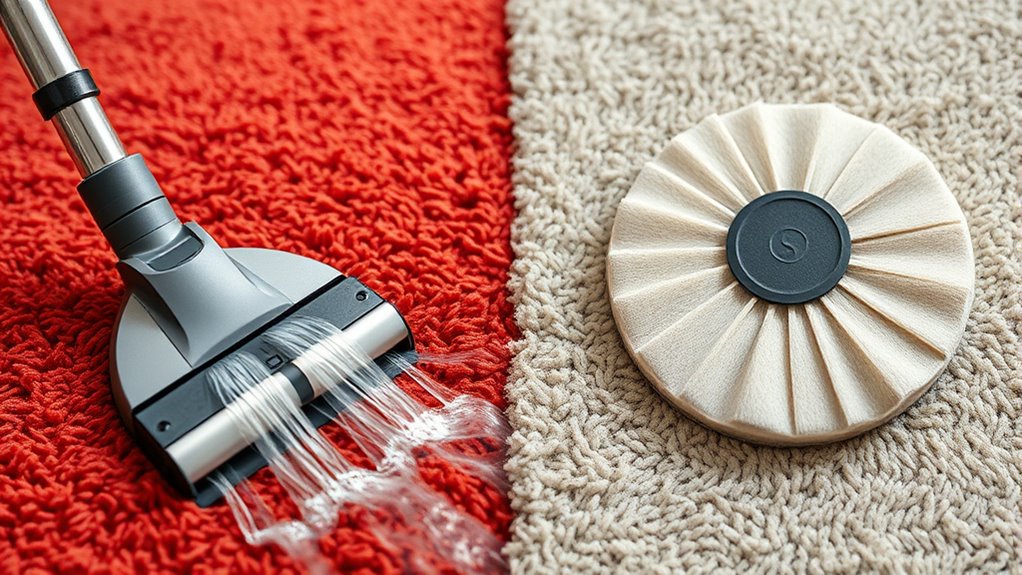
Although bonnet cleaning is quick and convenient, it has significant drawbacks that can affect its effectiveness. One major issue is that it often leaves behind dirt and residues, which can lead to quicker re-soiling. Additionally, the process can cause fiber damage over time if not performed properly. You may also find that bonnet cleaning doesn’t reach deep into the carpet fibers, leaving grime embedded below the surface. Proper exfoliation techniques are essential to prevent residue buildup and maintain carpet longevity. Here’s a comparison of common concerns:
| Concern | Impact | Why it Happens |
|---|---|---|
| Surface-level cleaning | Dirt remains, quick re-soiling | Limited penetration |
| Fiber damage | Reduced carpet lifespan | Friction and harsh pads |
| Residue buildup | Sticky surface, attracts dirt | Use of improper cleaning agents |
These drawbacks highlight why bonnet cleaning isn’t ideal for deep, long-lasting results.
Effectiveness in Deep Cleaning and Dirt Removal
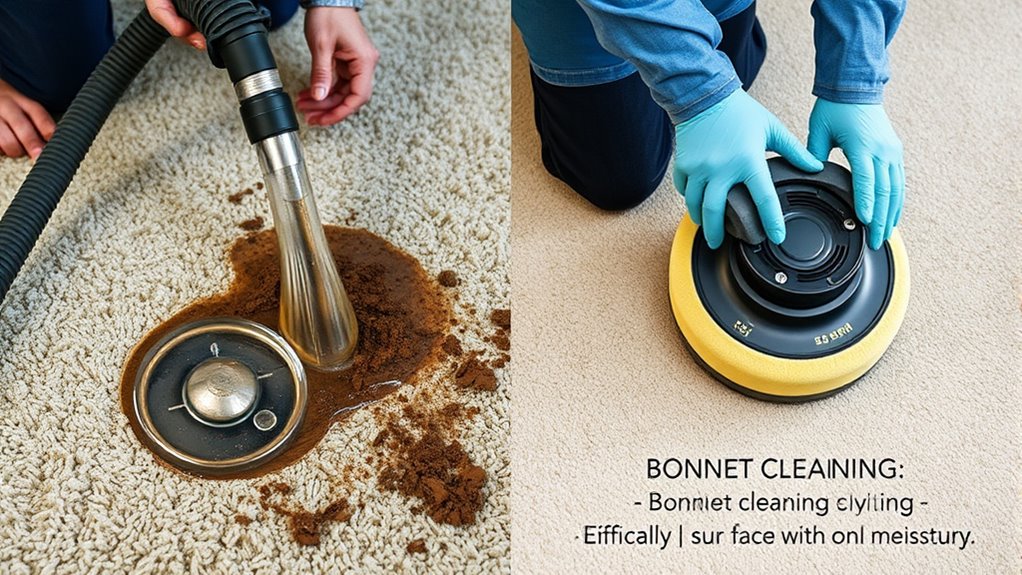
While bonnet cleaning offers quick results on the surface, it often falls short when it comes to deep cleaning and removing embedded dirt. This method mainly cleans the surface layer, leaving dirt and debris trapped beneath. To understand its limitations, consider these points:
- It doesn’t penetrate deeply into the carpet fibers.
- Dirt particles often remain hidden beneath the surface.
- It relies on surface agitation, which can push dirt further down.
- Stains and grime can resurface quickly after cleaning.
- Proper cleaning technology ensures more effective removal of deeply embedded dirt, making water extraction a superior choice for thorough cleaning.
As a result, bonnet cleaning may look clean initially but doesn’t effectively remove the deeply embedded dirt that impacts your carpet’s overall cleanliness and longevity. If deep dirt removal is your goal, water extraction tends to be more thorough.
Time and Drying Time Considerations

When choosing a carpet cleaning method, considering the time and drying process is essential. Water extraction typically takes longer to dry because it involves deep cleaning with significant moisture. Expect carpets to take 6-12 hours or more to fully dry, depending on humidity and ventilation. This downtime can disrupt your schedule, especially if you need your carpets ready quickly. Bonnet cleaning, on the other hand, dries much faster—often within an hour—since it uses minimal moisture. If you’re pressed for time or need a quick turnaround, bonnet cleaning offers a faster solution. However, keep in mind that faster drying doesn’t always mean better cleaning results. Balancing your schedule with the desired cleaning quality will help you decide which method suits your needs best. Additionally, the automation technologies used in modern carpet cleaning equipment can further influence efficiency and drying times.
Suitability for Different Carpet Types and Situations
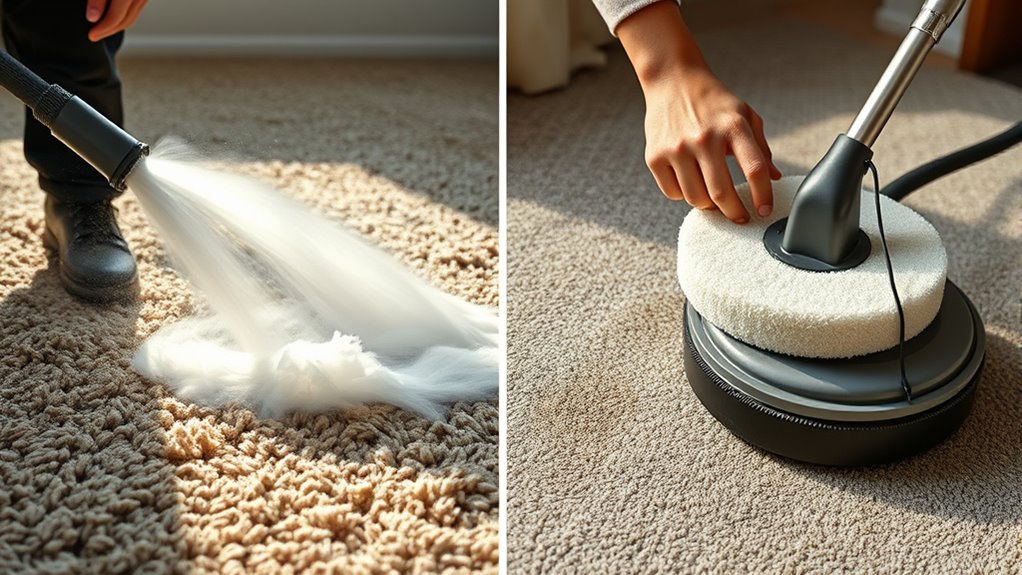
Choosing the right cleaning method depends heavily on your carpet type and the specific situation. Water extraction and bonnet cleaning each excel in different scenarios. For instance, consider these situations:
Selecting the best cleaning method depends on carpet type and specific cleaning needs.
- High-traffic areas: Water extraction removes deep dirt effectively, making it ideal.
- Delicate fibers: Bonnet cleaning is gentler, suitable for wool or silk carpets.
- Stain removal: Water extraction penetrates deeper for stubborn stains, while bonnet cleaning is better for surface stains.
- Frequent cleaning needs: Bonnet cleaning offers quicker turnaround, ideal for commercial spaces with regular traffic.
Cost Implications and Maintenance Factors

When choosing between water extraction and bonnet cleaning, understanding the cost implications is essential. You’ll want to take into account initial service expenses, ongoing maintenance costs, and the investment needed for equipment. These factors can considerably impact your long-term budget and cleaning routine. Additionally, considering the electric cleaning equipment used can influence efficiency and overall costs.
Initial Service Expenses
Have you considered how the initial costs of water extraction and bonnet cleaning compare? Typically, water extraction requires a higher upfront investment due to specialized equipment and trained technicians. Here’s what influences costs:
- Equipment expenses – water extractors are more costly than bonnet cleaning machines.
- Labor – water extraction often takes longer, increasing labor costs.
- Setup time – more extensive prep is needed for water extraction.
- Supplies – higher-quality detergents and tools can add to expenses.
While water extraction may seem pricier initially, it often provides deeper cleaning. Bonnet cleaning, on the other hand, usually involves lower setup costs but might require more frequent cleanings, which can impact your long-term budget. Consider these factors carefully before choosing your cleaning method.
Long-term Upkeep Costs
Long-term upkeep costs can substantially impact your overall budget, as they depend on the durability and maintenance needs of each cleaning method. Water extraction generally leaves carpets cleaner longer, reducing the frequency of deep cleanings and associated costs. It also minimizes residue buildup that can cause quicker soiling, saving you money over time. Bonnet cleaning, on the other hand, often requires more frequent treatments because it tends to leave behind residues that attract dirt. This means you’ll spend more on regular maintenance and possibly earlier carpet replacement. Additionally, if carpets aren’t properly maintained, premature wear and tear can increase costs. Consequently, considering how often you’ll need to perform upkeep and the longevity of the cleaning results helps you better estimate long-term expenses.
Equipment Investment Needs
Choosing between water extraction and bonnet cleaning involves contemplating the initial equipment costs and ongoing maintenance. Water extraction equipment typically requires a larger upfront investment, including a powerful vacuum, hot water system, and extraction tools. Bonnet cleaning, on the other hand, involves less expensive equipment but may require replacement or upgrades over time. Key factors to consider are:
- Initial purchase price of machines
- Frequency of maintenance and calibration
- Replacement parts and consumables
- Downtime for repairs or upgrades
Water extraction machines often cost more initially but can be more durable with proper care. Bonnet cleaning equipment is more budget-friendly upfront but may incur higher long-term costs due to frequent replacements. Your choice impacts your overall investment and ongoing expenses.
Frequently Asked Questions
Which Cleaning Method Is Better for Allergy Sufferers?
If you’re an allergy sufferer, water extraction is generally better because it thoroughly removes deep-seated dirt, dust, and allergens from your carpets. This method uses hot water and powerful suction, leaving less residue behind. Bonnet cleaning, on the other hand, only cleans the surface and can push allergens deeper into the fibers. So, choosing water extraction helps you breathe easier and reduces allergy symptoms more effectively.
How Do Water Extraction and Bonnet Cleaning Compare Environmentally?
Think of carpet cleaning methods as two explorers on a quest—each with different trails. Water extraction uses less chemicals, making it more eco-friendly and reducing runoff pollution. Bonnet cleaning often relies on harsh detergents that can harm the environment. If you’re eco-conscious, water extraction’s gentle approach is like a clean breeze for your home and planet, while bonnet cleaning might leave a more significant ecological footprint.
Can Both Methods Be Used Together for Optimal Cleaning?
You can definitely combine water extraction and bonnet cleaning for better results. Using water extraction first loosens dirt and deeply cleans the carpet, while bonnet cleaning on the surface helps remove remaining grime and refresh the look. This combo can be especially effective in high-traffic areas, ensuring thorough cleaning without over-wetting. Just make sure to follow proper procedures so you don’t damage the carpet or leave residues behind.
What Are the Safety Concerns Associated With Each Technique?
When considering safety concerns, you should be aware that water extraction involves heavy equipment and large amounts of water, which can cause slips or electrical hazards if not handled properly. Bonnet cleaning uses rotating brushes that might damage delicate fibers or spread dirt if misused. Always guarantee proper training, use personal protective gear, and follow manufacturer instructions to minimize risks with either method.
How Often Should Each Cleaning Method Be Performed?
You should schedule water extraction every 12 to 18 months for deep cleaning, especially in high-traffic areas or if you notice stains or odors. Bonnet cleaning is suitable for routine maintenance and can be done every 3 to 6 months. Regular cleaning helps maintain your carpet’s appearance and longevity. Adjust the frequency based on foot traffic, pets, and spills to keep your carpets fresh and clean.
Conclusion
Choosing between water extraction and bonnet cleaning depends on your specific needs. Water extraction offers deep cleaning but takes longer to dry, while bonnet cleaning is quicker and suited for routine maintenance. Keep in mind, each method has its pros and cons—no one-size-fits-all solution. Ultimately, understanding their differences helps you make an informed decision, so you don’t end up barking up the wrong tree. Select the right approach to keep your carpets looking their best.
